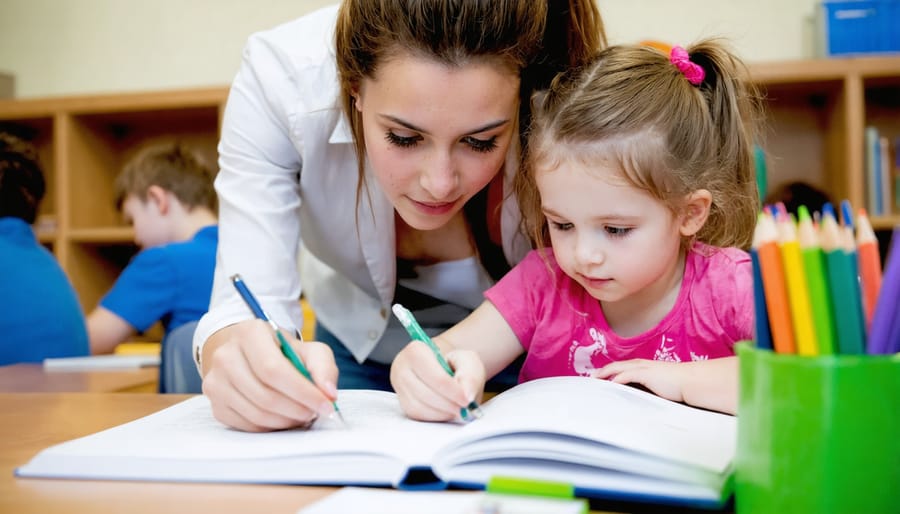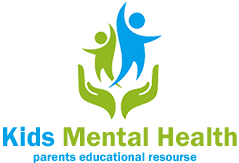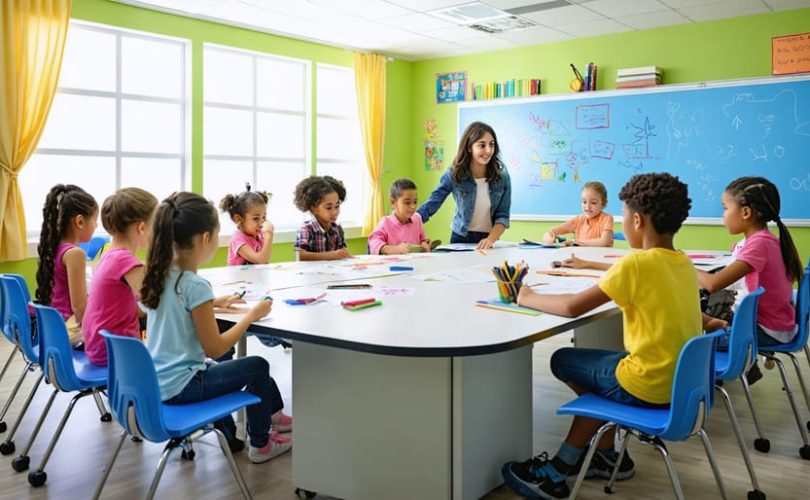Education transforms lives for students managing mental health conditions, yet traditional academic approaches often fall short of meeting their unique needs. Creating effective mental health in schools requires a delicate balance between academic achievement and emotional well-being.
Recent studies show that 1 in 5 students struggle with mental health challenges, making it crucial to implement comprehensive educational strategies that support both learning and healing. These students aren’t just fighting to maintain grades – they’re navigating a complex journey that demands understanding, flexibility, and targeted support from educators and healthcare providers alike.
By reimagining education through a mental health-conscious lens, we can create learning environments that nurture academic growth while honoring each student’s mental health journey. This integrated approach doesn’t just benefit students with diagnosed conditions; it fosters a more compassionate, inclusive educational system for everyone involved.
Success in this arena requires collaboration between teachers, mental health professionals, families, and students themselves. When we prioritize both educational achievement and mental wellness, we pave the way for students to thrive not just academically, but as whole, healthy individuals prepared for life’s challenges.
Understanding the Educational Needs of Mental Health Patients
Common Learning Barriers
Students with mental health conditions often face several barriers that can impact their educational journey. ADHD learning challenges frequently manifest as difficulty maintaining focus and completing tasks, which can significantly affect classroom performance. Anxiety may cause students to struggle with class participation, test-taking, or even attending school regularly.
Medication side effects can present additional challenges, such as drowsiness, difficulty concentrating, or changes in energy levels throughout the day. These effects may vary depending on dosage timing and individual responses to treatment.
Depression can impact motivation and memory retention, making it harder for students to engage with learning materials or remember important information. Some students might also experience social isolation, which can affect group work and peer learning opportunities.
Processing difficulties, whether related to trauma or other mental health conditions, may require additional time for understanding and completing assignments. It’s important to remember that these barriers can fluctuate in intensity, requiring flexible and individualized support approaches to ensure successful learning outcomes.
Social and Emotional Considerations
Students with mental health conditions often face unique social challenges in educational settings. Building and maintaining peer relationships can be particularly difficult, especially when symptoms or treatments impact regular attendance or social interactions. As Sarah Thompson, a school counselor with 15 years of experience, notes, “Creating a supportive classroom environment where students feel accepted and understood is crucial for their emotional well-being.”
Addressing stigma remains a significant concern. Education staff can help by promoting mental health awareness and fostering an inclusive atmosphere where differences are respected. This might include classroom discussions about empathy and understanding, or implementing anti-bullying programs specifically addressing mental health stigma.
Self-esteem building should be integrated into daily educational practices. This can include celebrating small achievements, providing opportunities for leadership roles, and ensuring students have chances to showcase their strengths. Teachers can work with mental health professionals to develop strategies that boost confidence while maintaining appropriate academic expectations.
Parents report that when schools successfully address these social and emotional aspects, students show improved academic performance and better treatment outcomes. Regular communication between educators, families, and mental health providers helps ensure these social supports remain consistent and effective.
Creating Supportive Learning Environments

Classroom Modifications
Creating an effective learning environment for students with mental health conditions often requires thoughtful modifications to the physical classroom space. Simple changes can make a significant difference in helping students feel comfortable and ready to learn.
Lighting adjustments are crucial, as harsh fluorescent lights can trigger anxiety or sensory sensitivities. Installing dimmer switches or providing areas with natural lighting offers students options for their comfort level. Some classrooms benefit from designated quiet corners with soft seating and calming colors, giving students a safe space to decompress when feeling overwhelmed.
Seating arrangements should be flexible to accommodate different needs. Some students may concentrate better near windows, while others might prefer sitting closer to the teacher or near the door for easy breaks. Using privacy screens or study carrels can help students who struggle with focus or social anxiety.
Storage solutions for fidget tools, stress balls, or other comfort items should be easily accessible but not distracting. Visual aids, schedules, and organizational tools posted on walls can help students stay oriented and reduce anxiety about daily routines.
Temperature control and good ventilation are important considerations, as physical comfort significantly impacts mental well-being and learning ability. When possible, incorporating elements of nature, such as plants or nature-themed artwork, can create a more calming atmosphere.
Remember that modifications should be implemented discretely to avoid singling out any student while benefiting everyone in the classroom.
Teaching Approaches
Teaching students with mental health conditions requires a flexible and individualized approach that acknowledges each student’s unique needs and circumstances. Successful educators often combine traditional teaching methods with adaptive strategies that accommodate varying energy levels, attention spans, and emotional states.
One effective approach is the “chunk and check” method, where complex lessons are broken down into smaller, manageable segments. This allows students to process information at their own pace while maintaining a sense of achievement. Teachers might incorporate frequent breaks, provide multiple ways to demonstrate understanding, and offer alternative assessment methods when standard testing proves challenging.
Visual aids, hands-on activities, and multimedia resources can help engage students who struggle with traditional lecture-style teaching. Some students might benefit from recorded lessons they can review later, especially during periods when attending class is difficult. Peer learning and collaborative projects can also foster social connections while building academic skills, though it’s important to be mindful of each student’s comfort level with group work.
Flexibility in deadlines and assignment formats shows understanding while maintaining academic standards. For instance, a student experiencing anxiety might prefer oral presentations in a private setting rather than in front of the class. Regular check-ins and open communication between teachers, students, and mental health professionals help ensure teaching approaches remain effective and responsive to changing needs.
Collaborative Care Teams

Communication Strategies
Effective communication between schools, healthcare providers, and families forms the foundation of successful educational support for students with mental health needs. Creating a unified support system requires clear channels of information sharing and regular updates among all parties involved.
Schools can establish dedicated liaison officers who coordinate with mental health professionals and families, ensuring everyone stays informed about the student’s progress and needs. Regular case conferences, whether in-person or virtual, provide opportunities for collaborative decision-making and strategy adjustment.
Technology plays a crucial role in maintaining consistent communication. Secure messaging platforms, online portals, and scheduled video conferences make it easier for busy parents and healthcare providers to stay connected with educators. Many schools now use digital progress tracking systems that allow all stakeholders to monitor academic performance and behavioral patterns in real-time.
Documentation is equally important. Implementing standardized communication protocols helps track interventions, achievements, and concerns while maintaining student privacy. Consider creating communication notebooks or digital logs that travel between home and school, allowing daily updates and immediate feedback.
Remember that families may need different communication approaches based on their circumstances. Offering flexible meeting times and multiple communication channels ensures everyone can participate effectively in supporting the student’s educational journey.
Individual Education Plans (IEPs)
Individual Education Plans serve as roadmaps for students with mental health conditions, ensuring they receive appropriate educational support while managing their wellness. These personalized documents outline specific learning goals, accommodations, and strategies tailored to each student’s unique needs and circumstances.
When developing an IEP for a mental health patient, educators work closely with mental health professionals, parents, and sometimes the students themselves to create realistic and achievable learning objectives. These plans might include flexible scheduling, modified assignments, or alternative assessment methods that accommodate periods of heightened symptoms or treatment requirements.
For example, a student managing anxiety might benefit from extended test-taking time or a quiet study space, while someone dealing with depression may need adjusted deadlines or break-time allowances. Regular progress monitoring and plan adjustments ensure the IEP remains effective and responsive to the student’s changing needs.
The success of an IEP often depends on clear communication between all parties involved and a commitment to maintaining a supportive, understanding learning environment. Regular reviews and updates help ensure the plan continues to serve the student’s evolving educational and mental health needs effectively.
Supporting Academic Success
Flexible Scheduling
A key component of successful education for students with mental health conditions is the implementation of flexible scheduling that acknowledges their unique needs. Traditional rigid school schedules can create additional stress for students managing both their education and mental health treatment. By adapting academic timetables, schools can create a more supportive environment that promotes both recovery and learning.
As Sarah Thompson, a school counselor with 15 years of experience, explains, “When we allow students to adjust their schedules around therapy appointments and challenging periods, we see improved attendance and better academic outcomes.”
Flexible scheduling might include:
– Modified start times to accommodate medication schedules
– Reduced course loads during intensive treatment periods
– Extended deadlines for assignments when needed
– Break periods throughout the day for stress management
– Alternative attendance patterns during recovery phases
Many schools have found success with hybrid learning options, allowing students to combine in-person and remote learning when necessary. This approach particularly benefits students who may have periods where attending school physically is challenging.
“The key is maintaining open communication between teachers, parents, and healthcare providers,” notes Dr. Michael Chen, an educational psychologist. “When everyone works together to create a schedule that supports both academic progress and mental health needs, students are more likely to succeed.”
Remember that flexibility doesn’t mean lowering expectations – it means creating realistic pathways for students to achieve their educational goals while prioritizing their mental health journey.

Assessment Modifications
Students with mental health conditions often require modified assessment approaches to accurately demonstrate their knowledge and capabilities. These adjustments ensure fair evaluation while maintaining academic standards.
Common assessment modifications include extended time for tests and assignments, which helps reduce anxiety and allows students to work at a comfortable pace. Some students benefit from taking exams in quiet, separate rooms to minimize distractions and stress triggers.
Breaking larger assignments into smaller, manageable chunks can make tasks less overwhelming. Teachers might offer alternative presentation formats – for instance, allowing a written report instead of an oral presentation for students with social anxiety.
Multiple assessment methods provide students various ways to showcase their understanding. This might include project-based assessments, portfolios, or verbal explanations instead of traditional written tests. Some students may need frequent breaks during evaluations or the option to complete assessments during their optimal times of day.
Technology can play a valuable role, with options like speech-to-text software or digital tools for organizing thoughts. For students experiencing concentration difficulties, simplified test formats or reduced question sets might be appropriate while still covering essential learning objectives.
Remember that modifications should be individualized and regularly reviewed with input from mental health professionals, educators, and families to ensure they remain effective and appropriate for the student’s current needs.
Building Resilience and Self-Advocacy
Empowering students with mental health challenges to advocate for themselves and build resilience is crucial for long-term academic success. Research shows that building student resilience helps them better manage both their educational journey and mental health needs.
One effective approach is teaching students to recognize their triggers and early warning signs. By developing this self-awareness, they can proactively communicate their needs to teachers and support staff before challenges become overwhelming. For example, a student might learn to request a brief break when feeling anxious during class, rather than waiting until they experience a full anxiety attack.
Creating a personalized toolkit of coping strategies empowers students to take control of their well-being. This might include breathing exercises, mindfulness techniques, or positive self-talk methods they can use independently. Sarah, a high school counselor, shares: “When students have their own set of tools they trust, they feel more confident participating in regular classroom activities.”
It’s equally important to help students understand their rights and accommodations. Teaching them how to effectively communicate their needs to educators, when to ask for help, and how to participate in their educational planning meetings builds confidence and self-advocacy skills. This might involve role-playing conversations with teachers or practicing how to explain their accommodation needs professionally.
Remember that building resilience is a gradual process that requires patience and consistent support. Celebrate small victories and help students recognize their progress, as these positive experiences strengthen their belief in their ability to overcome challenges.
As we’ve explored throughout this article, education plays a vital role in the recovery and well-being of mental health patients. The successful integration of supportive educational practices requires dedication from teachers, healthcare providers, and families working together. By implementing flexible learning approaches, creating inclusive environments, and maintaining open communication channels, we can help students with mental health conditions thrive academically.
Remember that each student’s journey is unique, and what works for one may not work for another. The key lies in remaining adaptable and responsive to individual needs while maintaining high expectations for academic achievement. Through consistent support, understanding, and appropriate accommodations, we can help students build confidence, develop coping strategies, and progress in their educational goals.
Moving forward, let’s commit to breaking down barriers to education for mental health patients. By fostering environments where students feel safe, understood, and supported, we create opportunities for both academic success and emotional well-being. Together, we can ensure that mental health challenges don’t become obstacles to educational achievement, but rather opportunities for growth, resilience, and personal development.







